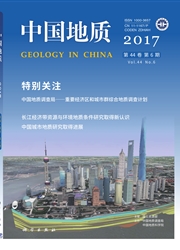

 中文摘要:
中文摘要:
本文通过对西昆仑西段地区晚古生代—中生代花岗岩的岩石类型、形成时代和岩石地球化学资料的综合分析,探讨花岗质岩浆活动期次、岩石成因,结合区域资料,探讨构造-岩浆演化特征和碰撞造山过程。将该地区晚古生代—中生代构造-岩浆演化分为7个阶段:(1)388~324 Ma(特提斯Ⅰ、Ⅱ支洋向北俯冲消减阶段),具富钠贫钾特征的低温TTG岩石组合,形成于陆缘弧环境;(2)339~291 Ma(奥依塔格弧后盆地演化阶段),由于南部特提斯Ⅰ支洋持续往北俯冲,导致西昆仑北缘发生弧后扩展而形成弧后盆地,形成拉斑质具强烈富钠贫钾特征的低温大洋花岗岩;(3)258~241 Ma(特提斯Ⅰ支洋闭合、碰撞造山阶段),岩石中发育石榴子石和白云母,普遍具片麻状构造,属于S型花岗岩,陆壳部分熔融的产物;(4)234~210 Ma(特提斯Ⅰ后碰撞伸展阶段):岩体规模较大,为I型→A型花岗岩,伴随着地幔岩浆底侵和强烈的壳幔岩浆混合作用;(5)198~150 Ma(特提斯Ⅱ支洋向南俯冲消减阶段):类似TTG的岩石组合,形成于与洋壳俯冲有关的岩浆弧环境;(6)148~118 Ma(特提斯Ⅱ支洋闭合、碰撞造山阶段):弱片麻状二云二长花岗岩,属C型埃达克岩,为陆-陆碰撞过程中陆壳加厚发生部分熔融的产物;(7)111~75 Ma(特提斯Ⅱ后碰撞伸展阶段):发育规模较大,钾玄质系列,是古老地壳部分熔融的产物。根据各阶段花岗质岩浆活动特征和构造演化过程,初步提出了西昆仑西段晚古生代—中生代大地构造演化模式图。
 英文摘要:
英文摘要:
On the basis of rock types, ages and geochemical data of Neopaleozoic and Mesozoic granites, the authors studied themagmatic stages and petrogenesis of these granites, and discussed tectonic magmatic evolution and collision orogenic process of the western West Kunlun Mountains in combination with the regional geological information. The authors have reached the conclusion that the tectonic magmatic evolution of Neopaleozoic and Mesozoic period should be divided into seven stages:(1) 388- 324 Ma(northward subduction of Branch I of Tethys Ocean): granites at this stage had TTG rock association with rich sodium and poor potassium, probably formed in an epicontinental arc;(2) 339-291 Ma(Oytag back-arc basin): this back-arc basin was formed by northward subduction of Branch I of Tethys Ocean in the south, and subsequent tholeiitic ocean granites might be characterized by rich sodium and poor potassium;(3) 258-241 Ma(the stage of the closure of Branch I of Tethys Ocean and collision orogeny): the granites of this stage were gneissic S-stye granites with muscovite and garnet which should have originated from continental crust;(4) 234-210 Ma(the post collision extensional stage during TethysⅠ): huge granitic batholiths were I-A style granites which were closely associated with mantle magma underplating and magma mixing;(5) 198- 150 Ma(southward subduction of Branch II of Tethys Ocean): granites of this stage had TTG rock association and were formed in continental marginal arc or island arc setting;(6)148- 118 Ma(the stage of closure of Branch II of Tethys Ocean and collision orogeny): monzonitic granites with weak gneissic structure belonged to C style adakites as a result of melting of thickening crust during continental collision;(7) 111-75 Ma(the post collision extensional stage during Tethys Ⅱ): the massive granites belonged to shoshonitic series formed by partial melting of ancient crust. The authors put forward a tectonic evolution model fo
 同期刊论文项目
同期刊论文项目
 同项目期刊论文
同项目期刊论文
 期刊信息
期刊信息
